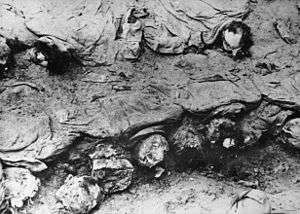Mass graves in the Soviet Union

Mass graves in the Soviet Union were used for the burial of mass numbers of citizens and foreigners executed by the government. The government of the Soviet Union under Joseph Stalin murdered many of its own citizens and foreigners.[1] These mass killings were carried out by the security organisations, such as the NKVD, and reached their peak in the Great Purge of 1937–38, when nearly 700,000 were executed by a shot to the base of the skull. Following the demise of the USSR in 1991, many of the killing and burial sites were uncovered.
Soviet repression and terror
Stalin's regime is believed to have caused the deaths of approximately 20 million people.[2] Most of them were Soviet citizens. Some of the more notable mass graves include:
- Bykivnia – containing an estimated 100,000–225,000 corpses[3][4]
- Kurapaty – estimations range from 30,000 to 200,000 bodies found[5]
- Butovo – over 20,000 confirmed killed[6]
- Communarka - about 10.000 killed [7]
- Sandarmokh – over 9,000 bodies discovered[8]
Other Stalin-era killing fields have been discovered,[9][10][11] one as recently as 2010.[12] In the areas near Kiev alone, there are mass graves in Uman, Bila Tserkva, Cherkasy and Zhytomyr.[13] Some were uncovered by the Germans during World War II; Katyn and Vinnitsa being the most infamous[14]
In July 2010, a mass grave was discovered at St. Petersburg, which contained the corpses of 80 military officers executed during the Bolshevik "Red Terror" of 1918-21.[15]
See also
References
- ↑ "Documenting the Death Toll: Research into the Mass Murder of Foreigners in Moscow, 1937–38" By Barry McLoughlin, American Historical Association, 1999
- ↑ Werth, Nicolas; Panné, Jean-Louis; Paczkowski, Andrzej; Bartosek, Karel; Margolin, Jean-Louis (October 1999), Courtois, Stéphane, ed., The Black Book of Communism: Crimes, Terror, Repression, Harvard University Press, p. 4, ISBN 978-0-674-07608-2, hardcover, 858 pp.
- ↑ "Ukraine reburies 2,000 victims of Stalin's rule". Reuters. 27 October 2007
- ↑ (English) Michael Franklin Hamm (1995). Kyiv. Princeton: Princeton University Press. ISBN 0-691-02585-1.
- ↑ Twentieth Century Atlas - Casualty Statistics - Biggest Battles and Massacres - Kuropaty
- ↑ "Former Killing Ground Becomes Shrine to Stalin’s Victims" by Sophia Kishkovsky, The New York Times, June 8, 2007
- ↑ Спецобъект "Монастырь" izvestia.ru.
- ↑ "Pictorial essay: Death trenches bear witness to Stalin's purges" CNN, July 17, 1997
- ↑ "Mass grave found containing Stalin victims" LA Times-Washington Post News Service, July 13, 1997
- ↑ "Mass grave found at Ukrainian monastery", BBC, July 12, 2002
- ↑ "Wary of its past, Russia ignores mass grave site", by Fred Weir, The Christian Science Monitor, October 10, 2002
- ↑ Stalin-era mass grave yields tons of bones Reuters. June 9, 2010
- ↑ Hiroaki Kuromiya, The Voices of the Dead: Stalin's Great Terror in the 1930s. Yale University Press, December 24, 2007. ISBN 0-300-12389-2 p. 23
- ↑ Richard Rhodes. Masters of Death: The SS-Einsatzgruppen and the Invention of the Holocaust. p. 149: "Vinnitsa had already been brutally purged in 1937 and 1938 by the NKVD. In the early summer of 1943, with unparalleled audacity, the SS would publicly exhume the victims of the NKVD killings in Vinnitsa; in three mass grave sites in an orchard, a Russian Orthodox cemetery and a public park near the town stadium, the homicide squad the SS sent from Berlin would find 9,432 bodies, of which 169 were female. With one exception, all the men had been bound, and most of the victims had been killed with shots to the head with small-caliber weapons. The victims had been “enemies of the people,” not specifically Jews, and included a large number of collective farm workers and priests. The Nazi authorities would invite forensic experts from the International Commission of Foreign Medical Examiners to observe the exhumations, hoping to focus international attention on the Soviet atrocities comparable with the attention that followed the discovery earlier in 1943 of the 1940 Soviet massacre of twelve thousand Polish officers in the Katyn Forest, 125 miles west of Moscow.”
- ↑ More 'red terror' remains found in Russia UPI, July 19, 2010.